Promoting Information Literacy Through the Arts: An Innovative Approach to Youth Development — Judith V. Rogers and Meerabai Gosine–Boodoo
Abstract
The paper reports on a literacy pilot project conducted in St. Croix, United States Virgin Islands (USVI) from 2006 to 2007. The project was undertaken to introduce the ideals of a learning community to a group of students, while teaching survival skills such as basic literacy and information literacy (IL). A novel method was adopted by linking literacy instruction to engagement in culture and the arts. Personnel with a wide range of skills and talents were selected for this non-traditional approach. The project results indicated that the venture was a success, as it offered a model that demonstrated how the intellectual and creative potential of young people could be channelled towards personal and national development.
Introduction
The St. Croix youth literacy project to be discussed highlights the problem of a declining literacy rate in a number of Caribbean countries and underscores the urgency to arrest this growing phenomenon. St. Croix is a Caribbean island by location, but belongs to a territory of the United States of America (USA) known as the United States Virgin Islands (USVI). Financial aid notwithstanding, poor academic performance and attendance by USVI youths continue to be recorded in the territory’s assessments of performance on standardized tests and in its statistics on school dropouts.
Recent findings from the 2005/2006 Virgin Islands Territorial Assessment of Learning (VITAL), which measures public school achievement, showed that only 20 percent of St. Croix’s elementary schools, none of the middle schools, and just one of the two high schools met the Adequate Yearly Progress (AYP) targets (U.S. Virgin Islands Kids Count Data Book, 2007). It is important to note that benchmarks for AYP are set at criteria such as: 95 percent school participation; specified percentages of students scoring at or above proficiency in reading and mathematics; and attendance rate at or progressing toward 95 percent. The same publication also reported that in the 2005/2006 school year the USVI Community Survey found that St. Croix schools accounted for 41 percent of the territory’s overall school dropout rate, while the islands of St. Thomas and St. John together made up the other 59 percent.
St. Croix’s students’ unsatisfactory performance in key elements of literacy may be linked to single parenting and low family incomes. In 2005, 40 percent of USVI children lived in households headed by single mothers and in 2004 one in six families (15.7 percent) survived on USD $15,000 or less per year (U.S. Virgin Islands Kids Count Data Book, 2007). Young people for whom high–level literacy is critical are not always motivated or able to enroll in alternative programs, even when they drop out of regular school. This set of circumstances has paved the way for an increase in the numbers of ‘detached youth’ who are neither in school nor employed and who are at greater risk of engaging in anti–social and crime–related activity (U.S. Virgin Islands Kids Count Data Book, 2007). A more serious consequence of the low–level literacy now flourishing in St. Croix is the island’s slow socio–economic progress, which is compounded by the frequency of natural disasters and its diminishing popularity with tourists.
In an attempt to alleviate the fallout effects of the literacy–poverty cycle on the student population, two key community stakeholders, the St. Croix Library Association (SCLA) and the Caribbean Museum Centre for the Arts (CMCArts), initiated the process of seeking international funding for a youth enhancement project. The SCLA and the CMCArts became joint applicants in 2006 for a USA grant that would support the building of skills capacity in a target group of students aged 9–19. This undertaking would involve instruction for skills set development with an emphasis on basic literacy and information literacy linked to the creative media.
Global Findings
Eyre (2003) described information literacy as a valuable acquisition that subsumes a wide variety of skills and abilities, including critical thinking; problem solving; personal, social and communication skills; and, library and computer literacy. Information literate people as identified by The Australian and New Zealand Information Literacy Framework: Principles, Standards and Practice (2004) possess the abilities to: recognize a need for information; access and use information ethically and legally; and use information and knowledge for participative citizenship and social responsibility.
Research findings also indicated that creating a literate nation is a challenge for countries, whether they are considered to be developed or developing. The evidence lies in the results of the Organization for Economic Cooperation and Development’s (OECD) adult literacy survey that was taken in 20 countries in 2000. The sample included the USA, Canada and the UK — yet one in every four adults was found to be without the necessary skills to manage in today’s world (Eyre, 2003). Literacy skills are generally recognized as important for nations to maintain or improve their standard of living and to compete in an increasingly global marketplace (Kirsch, 2001, p. 7). Reversal of low and declining literacy rates should therefore be treated as a priority national issue to ensure that the incoming labor force arrives equipped with the skills and competencies to develop and sustain their societies and economies.
The question of how libraries can meet the needs of everyone including those without literacy skills has become a burning issue. Jones (1991) observed that libraries catered well to literate adults and particularly English–reading adults. From the perspective of a multilingual developing country, she urged libraries to initiate literacy programs either on their own or in conjunction with other government departments and community organizations. She advocated community partnering driven by librarians, creative thinking and the production of local learning materials based on culture and environment, elements that were embraced by the SCLA and the CMCArts.
Tapping into non-traditional resources for successful social interventions was highlighted by Kaplan, et al. (2006) who used a model and pilot study in which informal teaching and guidance from senior adults in retirement communities were integrated into a youth project. The authors reported that in intergenerational approaches both youths and seniors (often disempowered groups) reaped mutual benefits by feeling valued, empowered and socially engaged. Meaningful contributions from one group to the other included enhanced student learning in several subject areas and increased school attendance, as well as increased memory function and enhanced physical mobility in adults.
The model for social intervention developed by the SCLA and the CMCArts incorporated some welcome innovations reported in library science, literacy and gerontology research. The pilot project’s success was predicted by (Nicholson, et al., 2004, p. 67) who concluded that “well–designed, well–implemented youth–centered programs that consciously use a youth–development model have positive outcomes for both the young people who participate and the communities that sponsor them.”
Purpose of the Project
The purpose of the project, “Promoting Literacy through the Arts: Solutions for the USVI” (PLTTA) was to create a model of a ‘learning community’ by coordinating the teaching of arts and crafts with literacy instruction to create a single program. The pilot was designed so that children aged 9–19 from the town of Frederiksted, St. Croix, could further develop transferable literacy and information literacy skills and acquire occupational skills within the context of their cultural heritage.
Goals
The SCLA and the CMCArts crafted these goals for the project:
Start the process of building a learning community within the framework of an education curriculum.
Enable students to acquire a higher level of survival and occupational skills through instruction and role modelling.
Start bridging the intergenerational gap between young people and seniors in the community by creating teaching and learning opportunities.
Design
A one–year skills program would be established and operated from October 2006 until September 2007
Young people registered as students in the Frederiksted area would be eligible to participate in the program
A project coordinator would be hired on a full–time basis to manage the logistics of the project. The coordinator would also maintain records of all activities and together with instructors and other personnel would ensure the collection and analysis of data needed to evaluate the project
Sessions would be held after school hours in the Fall and Spring semesters and the six weeks of the Summer vacation
The after–school and Summer classes would be held at the CMCArts facility
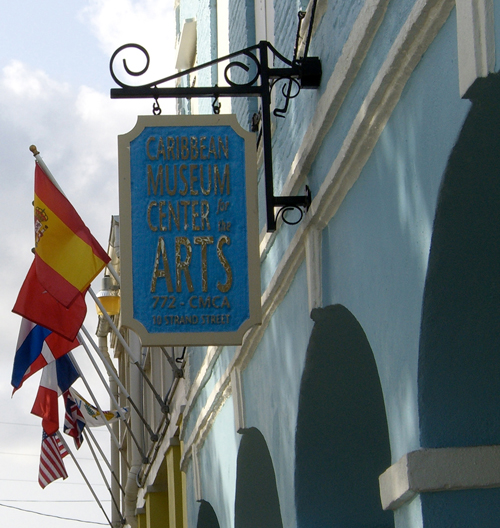 |
| Figure 1: Home of CMCArts, Fredericksted, St. Croix. |
A survey would be conducted to identify cultural and artistic skills desired by prospective participants. Responses would be compiled to create a range of options for participants
A grant proposal would be developed to source funds for project operating costs
Contributions would be invited locally from individuals and organizations
Sourcing Funds
The St. Croix Library Association (SCLA) in collaboration with the Caribbean Museum Center for the Arts (CMCArts) applied for funding for the PLTTA project from the Institute of Museum and Library Services (IMLS). A federal grant of USD $152,000 was awarded under the Institute’s 2006 National Leadership Grants for Libraries in the category of Advancing Learning Communities (http://www.imls.gov/results.asp). This particular grant is well sought after and is considered prestigious. SCLA, a registered non–profit corporation operating under its parent organization, Virgin Islands Library Association (VILA), accepted responsibility for managing the award. CMCArts also a registered non–profit corporation committed itself to co–management of the project with VILA. While the proposal was being drafted a qualified project coordinator was hired to serve on a full–time basis for the grant period (from 1 October 2006 to 30 September 2007) to oversee the implementation.
Implementation
With the financial needs met, the stakeholders (SCLA and CMCArts) turned their attention to project implementation. First, they decided upon a teaching curriculum that would realize the project’s goals while satisfying the interests of their prospective participants. Next, they co–opted a multi–skilled team for the teaching, training, coaching and counselling of students. Sixteen qualified instructors in the arts and crafts, five trainers, 16 senior adult assistants and 13 high school student interns were hired. The interns had been recommended as support personnel for the instructors by school principals and guidance counsellors. Strengthening the team were librarians, literacy tutors, and other skilled and talented persons who volunteered their services. Finally, two types of activities were selected to realize the intent of the project and to showcase it. The first was a skills instruction program designed in tandem with the learning outcomes and constructed to generate useful data. The second was a conference that would celebrate the project’s achievements and inspire the community at large.
Activity 1 — The Skills Instruction Program
Arts and Crafts: Participants were presented with a range of attractive options: oil and watercolor painting, charcoal sketching, air brushing and finger painting; basket and palm frond weaving; block printing and motif creation; dyeing techniques and batik design; cultural sewing; jeweler making; leather craft; creating pottery and ceramics; sculpting; calabash craft; and caning furniture.
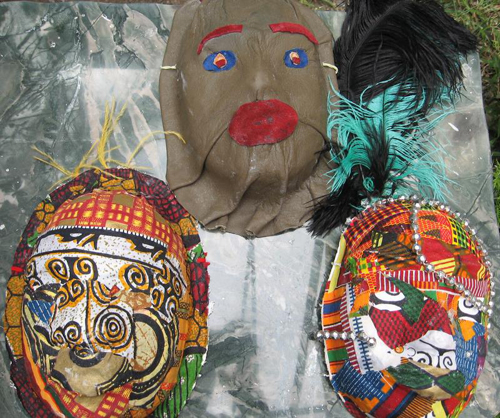 |
| Figure 2: Masks decorated with madras fabric reflecting historical traditions. |
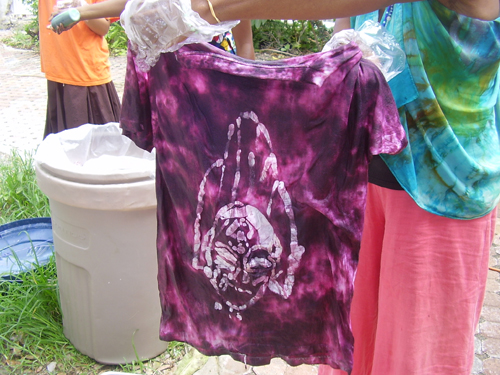 |
| Figure 3: Student proudly displays tie–dye design. |
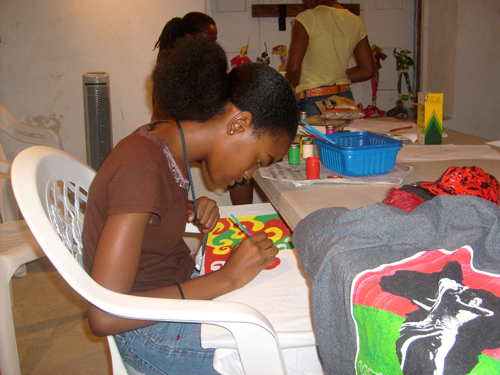 |
| Figure 4: Creating textile patterns was serious work engaging the students’ full attention. |
Music: Participants were taught to play calypso and Quelbe music, as well as African drumming.
Storytelling: Oral skills were taught along with aspects of Caribbean folkloric culture.
Dance: Participants could acquire indigenous dance skills such as Quadrille.
Basic Literacy: Tutors worked alongside students responding to individual needs to ensure that an adequate ability to read and write was achieved.
Research and Information Literacy: The relevant skills were taught in relation to any three of the arts, crafts and music skills chosen by participants. Librarians gave live presentations on literacy and created online tutoring services. Tutors and instructors together developed techniques and strategies to teach students good research skills.
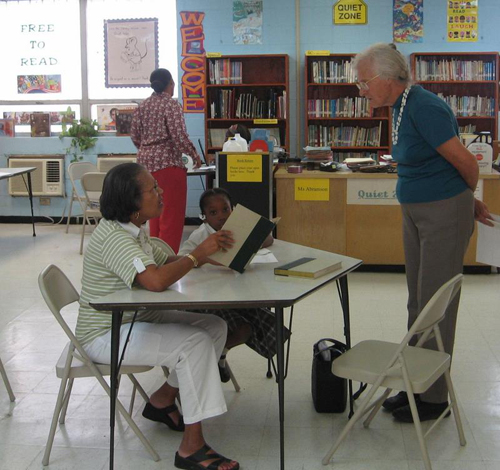 |
| Figure 5: Retired University English professor and school librarian together build student literacy skills. |
Entrepreneurship: Sessions on entrepreneurship included demonstrations on how to convert the mastery of these skills into economic benefit.
Work Ethics and Social and Citizenship Values: Sessions included a component called “The Virtues” that aimed to strengthen the character and moral values of participants.
Activity 2 — The Library/Museum Professional Conference
A one–day conference entitled “Literacy through the Arts: Innovative Options for Building Skills,” was held on 6 October 2007 at the St. Croix Campus of the University of the Virgin Islands (UVI). The event, which was funded by the grant, signaled the completion of the literacy pilot project. On that occasion the bonding between the main USVI stakeholders (SCLA and CMCArts) and the goodwill inspired by the project were evident to the attendees. The Conference was also acknowledged as a significant achievement by the Virgin Islands Library Association (VILA) and the St. Croix Library Association (SCLA), a Chapter of the VILA and a project stakeholder. For the VILA, this event was a milestone since the year 2007 marked the Association’s 35th year in existence.
The event attracted an estimated 90 persons including librarians from St. Thomas, St. John and St. Croix (USVI), Masters in Library and Information Science (MLS) students, museum personnel, school administrators and teachers, government officials and staff from the Department of Tourism (USVI), as well as parents and other members of the public. Among the motivational presentations was the keynote address by Robert Wedgeworth, retired Dean of the Library School at the University of Illinois (USA) and former President and CEO of ProLiteracy Worldwide (USA).
Data Collection
The literacy project coordinator, as the person responsible for data collection and analysis, welcomed the opportunity to participate in a preparatory online course offered by the IMLS entitled “Shaping Outcomes.” Student interns became better equipped to support data gathering after 40 hours of photo/video production training. The following data sets were used to assess the success of the project:
A daily attendance record tracking the participation of all persons involved with the project.
Digital recordings presented as a Summer Session documentary and an awards ceremony video.
Over 4,000 photographs capturing the activities and products generated by the project.
The 1,790 journal entries written by participants, including student interns, that described learning experiences and reflected attitudes, beliefs and progress.
Responses from interviews conducted using a sample of students selected on the basis of attendance and participation.
Evidence of achievement with a product created out of the arts and crafts instruction and with another in either written or digital media to demonstrate newly acquired research skills.
Results of the Gates–MacGinitie Reading Assessment pre– and post–tests administered through participating schools.
Results of an information literacy assessment adapted from the information literacy rubric published by the School Board of Broward County, Florida (USA).
Results
Classroom Engagement
Session I of the skills instruction program was offered from 14 November 2006 to 1 February 2007; Session II ran from 13 February 2007 to 30 May 2007 and the Summer Session was held over six weeks from 18 June 2007 to 27 July 2007. One hundred participants enroled either as students or student interns for the three sessions. They were between the ages of 8 and 18 and came from four of the five public and private schools targeted in the Frederiksted area.
A total of 308 program hours were completed in the Fall and Spring After–school Sessions and the Summer Session. The teaching team included instructors, senior adult assistants and student interns, with the latter providing added guidance and mentorship. One admirable example of teaching support was the 90–year–old senior assistant, Mrs. Ethel Harris, who offered tools to live by in her sessions on “The Virtues.”
Ten arts and crafts classes were offered in all. Three classes were held in the Fall (Cultural Arts and Crafts, Storytelling and Sewing), three in the Spring (Jewellery Making, Cultural Sewing, and Crafts and Textile Design), and four in the Summer (Textile Design, Traditional Dance and Music, Drawing/Sculpting/Painting and Jewellery Making/Arts and Crafts). In each session, students learnt at least three new artistic skills and completed one or more projects related to their cultural heritage.
Students participated in an estimated 30 hours of research, deepening their knowledge about the history of the art form, its evolution in the USVI and the achievements of key local culture bearers. Forty presentations, some live and some recorded, were conducted on a number of topics such as art, cultural heritage, entrepreneurship, USVI history, and literacy. During the after–school sessions, the students completed 10 research project boards with the support of library volunteers and staff.
Community Engagement
The Summer Session offered a stimulating package of activities where students were taken on seven field trips that included the local museum, a public library, a senior citizen recreation centre and a nature hike. Another highlight was an “Entrepreneurship Day” where personnel of the Small Business Development Centre in St. Croix illustrated the start–up of a small business, using oral presentations and skits that engaged students in role–play. Yet another event which excited participants was an essay competition through which entrants could demonstrate some of the literacy skills, library research skills and values that they had learnt.
Student Learning Outcomes
PLTTA’s learning objectives for the students were to have them improve the following: their attitude towards writing; knowledge about research; comprehension of specific aspects of information literacy; reading assessment scores; their understanding of the connection between the artistic skills learnt and their cultural heritage; and their application to and mastery of artistic skills.
To test the outcomes of these objectives, eight students were selected from a group that had completed two or more sessions. The criteria for selection were the duration of program involvement and availability for testing. Although small, the sample was considered representative of the larger group which had similar levels of participation.
Objective #1: Fifty percent of the students will improve their attitude towards writing.
Indicator: Number and percentage of target group that answered “yes” to the interview question: Do you feel your attitude about writing and research has changed for the better from being in this program?
Data Source: Recorded post—interview questions given at the end of each session.
Outcome: Seven out of eight students or 87.5 percent answered “yes.”
Objective #2: Fifty percent of the students will demonstrate improved knowledge about research.
Indicator: Number and percentage of target group that was able to answer the interview question sufficiently: What do you know about research that you didn’t know before joining this program?
Data Source: Recorded post—interview questions given at the end of each session.
Outcome: Eight out of eight students or 100 percent answered sufficiently to indicate improved knowledge about research.
Objective #3: Forty percent of the students will show improved comprehension of specific aspects of information literacy (based on the information literacy rubric of the School Board of Broward County (USA)).
Indicator: Number and percentage of target group that showed any improvement based on their information literacy interviews taken at the beginning and ending of each session.
Data Source: 4–point rubric scale, where 0 = not effective, 1 = somewhat effective, 2 = effective and 3 = very effective.
Outcome: Seven out of eight students or 87.5 percent showed an improvement on their scores in at least six out of the ten questions asked in their pre– and post–session surveys.
Objective #4: Thirty percent of students’ reading assessment scores will demonstrate a marked improvement.
Indicator: Number and percentage of target group that showed improved reading assessment scores after completion, in comparison with their performance before the programme.
Data Source: Gates–MacGinitie Reading Assessment Test administered to USVI students at their school at the beginning and ending of each school year. The test was comprised of 45 vocabulary questions and 48 comprehension questions totaling 93 questions.
Outcome: Four out of eight students or 50 percent showed the desired improvement increasing their overall scores by at least 10 points.
Objective #5: Sixty percent of the students will understand the relationship between their acquired artistic skills and their cultural heritage.
Indicator: Number and percentage of target group that was able to answer the interview question sufficiently: How do the artistic skills and projects that you learnt relate to your cultural heritage?
Data Source: Recorded post–interview questions given at the end of each session.
Outcome: Five out of eight students or 62.5 percent answered sufficiently to indicate an understanding of how the artistic skills learnt related to their cultural heritage.
An additional objective was established for students enrolled in the Summer Session to assess achievement of artistic skills. The sample consisted of 29 students and included students assessed in the other five objectives. The final objective was as follows:
Objective #6: Ninety percent of the students will demonstrate achievement in both application and mastery of artistic skills.
Indicator: Number and percentage of target group that indicated an improvement based on an artistic skills assessment. At the beginning and ending of the Summer Session each instructor was asked these questions:
(a)Did the student successfully apply the skills and techniques learnt in relevant art forms?
(b)Did the student master the use of tools of the trade in order to complete assignments?
Data Source: 3–Point Student Artistic Skills Assessment Survey, where 1 = not observed, 2 = observed occasionally and 3 = observed regularly.
Outcome: Twenty–seven out of 29 students or 93 percent enrolled in the Summer Session were said to have shown improvement.
Product Demonstrations
Achievements from the skills program were showcased to government officials, parents, school administrators and the community at large at appropriate settings:
Limitations of the Project
Despite the stakeholders’ best efforts, there were several factors that posed challenges to planned activities and the anticipated level of student participation. They were as follows:
Construction at the CMCArts facility, due to have been completed ahead of the program, was delayed, limiting the number of students who could be accommodated in classrooms and decreasing enrollment.
Transportation challenges affected enrollment during the term sessions.
Physical distance from the centre of program activities also resulted in a reduction in the high school level enrollment.
Students’ engagement in after–school employment to supplement their family’s income caused lower high school level enrollment as well.
The availability of fewer trainers than expected during the Summer Session because of personal and travel commitments resulted in multiple trainers being contracted. A team approach was therefore taken to the teaching of some topics.
One school, St. Patrick’s, had marked variations in its academic calendar when compared to the public schools and its students therefore started in Session II.
Conclusions
Overall, the PLTTA project appeared to have been successful in realizing its goals. A nurturing environment was created where students benefited from the intergenerational, educational, artistic and cultural connections needed for learning new skills and gaining meaningful experiences. Tangible achievements witnessed at the closing ceremonies, Conference and the Museum Center, in conjunction with the student learning outcomes indicated that the program had upgraded the creative and literacy skills of the pilot group and set participants on the path of viable occupations.
A second model evolved out of the implementation of this project as well. It was based on inter–organizational partnering for development and was realized through collaboration between two USVI organizations — the St. Croix Library Association (SCLA) and the Caribbean Museum Center for the Arts (CMCArts). Both had capitalized on their shared goals of commitment to the preservation and development of USVI material and emerged mutually strengthened. This kind of initiative promises to further the advancement of societies like the USVI, where lack of resources challenges the continued viability of all but firmly established and endowed organizations.
Future Plans
CMCArts received approval for a legislative appropriation of USD $75,000 in December 2007 to continue the PLTTA project beyond the pilot date. The approval of the additional funds enabled the project partners to request a no–cost extension from the IMLS to continue for another year based upon the same proposal. Savings accruing from the materials and supplies budget would supplement the legislative allocation. Another encouraging development was the completion of renovations to the CMCArts building in April 2008, which means improved accommodation for future classes.
Resource personnel such as professional librarians, artists and artisans have already committed to sustained support of this program. Graduates from the initial group are also being encouraged to volunteer time and contribute financially to continue this effort.
SCLA and CMCArts remain committed to partnering for a follow–up to this pilot project with CMCArts already seeking ways to institutionalize the PLTTA model territory–wide. To them, the results signify that this is a practical model for creating a learning community that starts with young people, those logically positioned to act as agents for change.
References
Bundy, Alan (editor). 2004. Australian and New Zealand information literacy framework: Principles, standards and practice. Adelaide: Australian and New Zealand Institute for Information Literacy, at http://www.caul.edu.au/info-literacy/InfoLiteracyFramework.pdf, accessed 30 November 2008.
Eyre, Gayner. 2003. “Back to Basics: the Role of Reading in Preparing Young People for the Information Society.” Reference Services Review 31, no. 3: 219–26. doi: 10.1108/00907320310486818.
Institute of Museum and Library Services. http://www.imls.gov/, accessed 28 January 2009.
Jones, Adele. 1991. “Libraries as centers for community literacy.” Information Development 7, no. 2: 86–88.
Kaplan, Matthew, Shih–Tsen (Nike) Liu, and Patricia Hannon. 2006. “Intergenerational engagement in retirement communities: A case study of a community capacity–building model” Journal of Applied Gerontology 25: 406–26. doi: 10.1177/0733464806292862.
Kirsch, Irwin. 2001. The International Adult Literacy Survey (IALS): Understanding what was measured. Princeton, N.J.: Educational Testing Service, Statistics & Research Division. http:// www.ets.org/Media/Research/pdf/RR-01-25-kirsch.pdf, accessed 19 January 2009.
School Board of Broward County, Florida. Learning resources and information literacy project pages: Rubric. http://www.broward.k12.fl.us/learnresource/project_page/rubric.htm, accessed 1 February 2009.
U.S. Virgin Islands Kids Count Data Book. 2007. Compiled and published by the Community Foundation of the Virgin Islands (CFVI). http://www.cfvi.net, accessed 30 December 2008.
Virgin Islands Daily News. http://www.virginislandsdailynews.com/index.pl/article_archive?id=17602681,accessed 28 January 2008.
Virgin Islands Daily News. http://www.virginislandsdailynews.com/index.pl/article_archive?id=176124121,accessed 28 January 2008.
2005 United States Virgin Islands Statistical Digest. St. Croix: Eastern Caribbean Center, University of the Virgin Islands, 2005.
Acknowledgements
The authors thank DeBorah Bellony, PLTTA Project Coordinator (1 October 2006–30 September 2007), Emily Graci, former Executive Director CMCArts, and Candia Atwater, Chairperson of the CMCArts Board of Directors.
About the authors
Judith Rogers is the Manager for Learning Resources and Faculty Technology Services in the Information and Technology Services component at the University of the Virgin Islands (UVI). She provides leadership for faculty curriculum and technology support. She has directed a variety of initiatives for UVI including a grant–funded, multi–agency digitization project, and is co–director for the current Digital Library of the Caribbean (dLOC) Project. She resides on St. Croix, U.S.V.I.
Meerabai Gosine–Boodoo is currently an academic librarian at The University of the West Indies in Trinidad and Tobago. She manages the cataloguing and indexing operations at the Medical Sciences Library, a key component of the University’s Campus Libraries system. Prior to this posting, she managed special libraries in industry and agriculture.